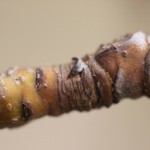Pear psylla adults are among the earliest pests to appear in tree fruit crops, and indeed after February’s record warmth adults are already active in southern counties. The first eggs were observed following last weeks warm up and oviposition will continue from now through bloom.
Dormant petroleum oil applications are a standard practice for early season psylla control. Unlike applications made for scale control and mite suppression, oil acts less as an insecticide and more as a method of exclusion since pear psylla adults tend not to lay eggs on oily surfaces. Therefore oil needs to be applied as early as weather and soil conditions permit. Usually the first applications are made in southern counties from mid to late March. However because of the early start to oviposition, applications should be made earlier this year.
These applications are useful throughout early bud stages and are generally long lasting; about 2 -3 weeks. In the dormant/delayed dormant stages apply a 2 % solution of oil (2 gals/100 or 6 gals/acre), or two applications of 1% through the green bud stage (when buds are swollen and green tissue is present). Adjust rates downward for later stages: 1% (1 gal/100) from swollen bud through green bud, or 2 applications of 0.5% (0.5 gals/100) from green bud through white bud (flower parts are visible). During the delayed dormant stages the addition of a pyrethroid or a growth regulator such as Centaur or Esteem may improve control. Centaur was observed to provide excellent control of summer nymphs in 2016. Sivanto combined with oil in the delayed dormant timing is an also an option. Sivanto should also control scale at this timing. Surround, a clay product, may also be applied with oil at a rate of 25-50#/ acre in the delayed dormant stages. Surround applications without oil can be applied through bloom to disrupt the entire oviposition period and has shown to provide good control of the first generation nymphs. Surround alone is also useful when temperatures are too cold to safely apply dormant oil. See the 2017 New Jersey Tree Fruit Production Guide for more information.


